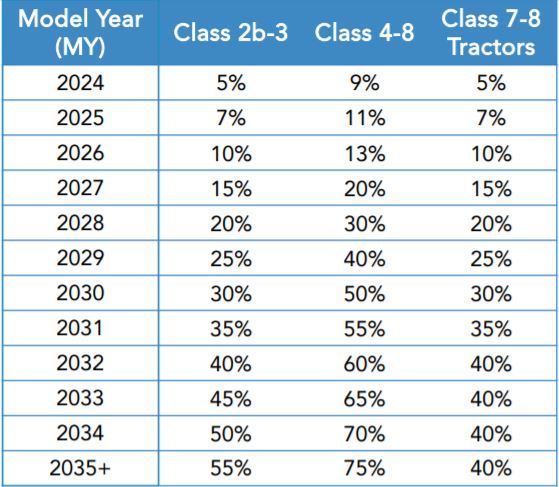California's Heavy-Duty Electrification Regulations
Advanced Clean Trucks
California’s Governor Newsom signed an Executive Order (N-79-20), which targets 100% of new light-duty vehicle sales to be zero-emitting (ZEVs*) by 2035, all drayage trucks to be ZEVs by 2035 and all buses and long-haul trucks to be ZEVs by 2045.To realize this Executive Order, California’s Air Resource Board (CARB) approved the Advanced Clean Trucks regulation in June 2020 and it goes into effect starting model year 2024. Manufacturers will have to sell an increasing portion of new vehicles as ZEVs and meet the requirements in the table shown here. As shown in this table, the requirements are not easy to meet: in less than a decade, the regulation will require every other Class 4 – 8 truck to be a ZEV (plug-in hybrid vehicles earn partial credits). However, mandating sales is only one side of the coin, and successful implementation will also require a market pull for the electric vehicles.
That will be address by the Advanced Clean Fleets, discussed next.
*ZEVs = Zero-emitting vehicles, defined as those with zero CO2 emissions at the tailpipe, as with electric and fuel-cell vehicles.

If you like such content, check out the monthly newsletter covering the latest on sustainable transportation technologies and regulations. Sign up below.
Like it ? Share it !
Other recent posts
Conference Summary – SAE WCX 2025
May 19, 2025
No Comments
![]()
A summary of the “SAE WCX 2025” conference held in Detroit.
IRENA Renewable Energy Capacity Statistics 2025
May 2, 2025
No Comments
![]()
According to the latest report from IRENA, 2024 saw the largest increase in renewable capacity, accounting for 92.5% of overall power additions.
CO2 Emissions Performance of Heavy-Duty Vehicles in Europe – 2022 Results
May 1, 2025
No Comments
![]()
The European Commission has published the official 2022 CO2 emission results for heavy-duty vehicles. Many OEMs are ahead of the targets and have gained credits, while others have their work cut out as we approach the 2025 target.
Tagged Heavy-duty regulations

